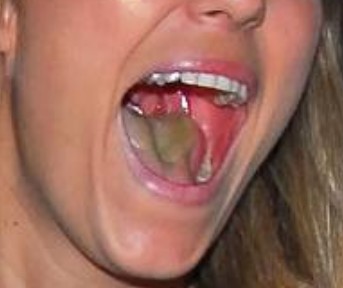The tongue is usually reddish pink in color, and the texture of a healthy tongue is typically smooth and velvety. Texture or color changes of the tongue can occur due to any type of oral infection, trauma, or formation of tongue sores.
It is a known fact that the general health of a person can usually be detected by the state of the oral cavity. Any type of abnormality affecting the mouth is therefore considered as a symptom of systemic or local problems. A green tongue is definitely regarded as a sign of some underlying health problem.
A green tongue may be caused due to varied causes. It is vital to diagnose the underlying cause of each instance of green tongue so as to be able to treat it effectively.
Causes and treatment of green tongue
Some of the common causes and associated treatments of green tongue are discussed below.
1. Oral Candidiasis
- Oral thrush is one of the most common causes of a green tongue. Oral thrush is a type of fungal infection of the mouth caused by Candida albicans. It is an opportunistic infection which typically affects individuals with a weakened immune system.It can also be observed in individuals who have been using ill-fitting prostheses or dentures for a long period of time.
- In most cases of oral candidiasis, the tongue usually changes color to white. The color may however change to a green tongue after the intake of antibiotics or after eating food. This layer of green color on the tongue can be easily removed, and the result is that a red, raw, and bleeding part of the tongue can be seen.
- In most cases, oral thrush usually affects the tongue’s dorsal surface. The infection may however occur in any part of the mouth. Patients may also experience additional symptoms such as bad breath, burning sensations in the mouth, and pain and discomfort after intake of spicy and hot food.
- Treatment of oral thrush associated green tongue infection involves use of topical anti-fungal medications. Patients also need to make sure that they are properly hydrated and consume a well-balanced diet.

2. Hairy Tongue Syndrome
- Unlike the name, the condition does not cause the growth of actual hair on the tongue.
- The dorsal surface of a normal tongue is velvety and soft to see and touch. This distinctive appearance can be attributed to the presence of tiny papillae called filiform papillae that occur on the tongue’s dorsal surface.These velvety-appearing papillae fall away or shed at scheduled intervals of time. Sometimes however, the papillae continue to grow but the cells do not fall away. As a result they look like long hair-like structures growing on the tongue’s dorsal surface.It is possible for these strands to become stained because of bacterial actions or contamination, eventually leading to the symptoms of a green tongue. The tongue color may even change to black.
- Diagnosis of such a green tongue is performed by microscopic examination or close investigation of the tongue for the presence of abnormally long papillae strands. Other symptoms associated with the disorder are metallic taste in the mouth and bad breath.
- Doctors are not aware about the precise cause of hairy tongue syndrome, but continuous smoking, increased use of mouthwash, and poor dental hygiene and health are thought to play a part in the development of hairy tongue related green tongue.
- Hairy tongue syndrome linked green tongue is treated by remedying the underlying causes and lifestyle changes such as quitting smoking and maintaining proper oral hygiene including daily brushing. Treatment of the underlying systemic disease will definitely cause the color of green tongue to return to normal.
Other Causes
Besides the above two primary causes, a green tongue can arise due to many other reasons as listed below:
- A green tongue may be caused as an extension of upper respiratory tract infection arising due to a sore throat.
- Tongue infections, smoking, excessive use of mouthwash, etc. can also result in a green tongue.
- Prolonged use of antibiotics can lead to a case of green tongue.
- Some types of toothpastes and mouthwashes have ingredients or dyes which may impart a greenish hue to the tongue.
- Consumption of green-colored candy or sucking on lollipops with green dyes in them may result in a green tongue. Such an instance of a green tongue is however temporary and does not cause any harmful symptoms.
- Use of illegal drugs and marijuana can sometimes result in a green tongue. Research is currently on to find out if this can be used as an option to detect drug use.
- People with a piercing in the tongue may develop a green tongue if the piercing becomes infected. A tongue piecing may pose problems in brushing and maintaining proper oral hygiene. This can attract secondary infection by candida fungus leading to a green tongue.

